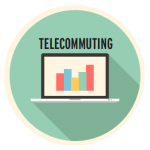Flexible work arrangements have been around for several decades now but—with the Internet and laptops and the rise of millennials—have become more prevalent for many professionals, including tax executives. For our second TEI Roundtable, we convened a conference call in January 2015 moderated by Tax Executive Senior Editor Michael Levin-Epstein with Vice President, U.S. and International Tax Randy Harvey, ConAgra Foods Inc.; Property Tax Adviser Ashley Krahn, Shell Oil Company; and Senior Director, U.S. Tax Marcy Miller, McDonald’s Corp.
Michael Levin-Epstein: Welcome to the second Tax Executives Institute Roundtable. At this roundtable, we’ll be discussing flexible work arrangements that have been successful and the lessons learned from those programs. The participants will be talking about flexible work arrangements at their companies and what this concept means for tax professionals.
Ashley Krahn: I am currently participating in a flexible workplace option, so I work from home one to two days a week, and I travel into one of our Houston locations three days a week. I have found that this flexibility has definitely helped my work-life balance. In my experience, it has proven to be beneficial to keep a structured schedule when possible so that everyone—both work and family—is familiar with the days that I’m going to be in the office and the days I’m working remotely.
 Marcy Miller: I’ve been doing a flexible work arrangement for almost 20 years. I think the first six months I had to prove myself. When my children were younger, I would work four days a week—a compressed work schedule. So I squeezed the 40 hours into four days a week, with the stipulation that I would be available for that fifth day. When tax time came, I would work overtime. Most of the year I could do it, but obviously during tax time, I couldn’t. Right now I work one day a week at home, and I think that in our department, out of 27 people, all but three do some kind of flexible work arrangement. Workers with younger children seem to do the compressed workweek, because they gain an extra day at home with their kids. People who are older tend to work one day a week at home. So we’ve been very successful with this.
Marcy Miller: I’ve been doing a flexible work arrangement for almost 20 years. I think the first six months I had to prove myself. When my children were younger, I would work four days a week—a compressed work schedule. So I squeezed the 40 hours into four days a week, with the stipulation that I would be available for that fifth day. When tax time came, I would work overtime. Most of the year I could do it, but obviously during tax time, I couldn’t. Right now I work one day a week at home, and I think that in our department, out of 27 people, all but three do some kind of flexible work arrangement. Workers with younger children seem to do the compressed workweek, because they gain an extra day at home with their kids. People who are older tend to work one day a week at home. So we’ve been very successful with this.
Randy Harvey: I’m coming at it from a different perspective than Ashley and Marcy. My comments will be about managing the folks who use flexible time versus using it myself. We implemented telecommuting and more formalized flexible work arrangements as a company about two and a half years ago, and, at the time, we discussed how it would work for us in tax. We came up with offering to anyone who would like to take advantage of telecommuting could work one day per week from home. And we laid out some ground rules: It’s truly a workday—it’s not a day to keep your kids home from day care or for running errands or doing housework or whatever else. You need to be available for meetings and phone calls if somebody has questions, just like you would if you were in the office. Initially, only six or eight of the 30 folks on my team took advantage of it. For various reasons, other people were not interested. As time has gone on, I think a few more people have taken advantage of it. After laying out the ground rules and emphasizing to people that the most important thing to me is getting your work done on time, meeting your deadlines, and supporting the business as needed, we have not really had any issues with the telecommuting part or with people not keeping up with their workloads or being available as needed. Sometimes something important is going on, or they need to be in the office for a meeting, or provision time may trump the telecommuting, and that’s just where they need to use their discretion. But I think people generally make good choices. In addition to telecommuting, we also offer flexible scheduling, where some people come in earlier or later, and we’re also very flexible around family activities or personal time or anything else that might be going on in their personal schedule that impacts the workday. We’ve had good success with all that. In addition, the company has implemented what we call summer Fridays. So between Memorial Day and Labor Day most people in the company—now obviously the plant situation doesn’t work, and there are also some restrictions around customer service and things like that—but most people in an office environment are able to work forty hours in what would be called a compressed work-week from Monday through 1 p.m. on Friday and have kind of a two-and-a-half-day weekend. That’s been successful and very well received by the employees. We also have had the same summer hours schedule between Thanksgiving and New Year’s as part of meeting our United Way contribution goal.
Miller: We have summer Fridays too at McDonald’s.
Feedback from Employees
Levin-Epstein: From the point of view of the employees, what do you think is the greatest benefit to the flexible work arrangements? What have they told you, either through satisfaction surveys or anecdotally, about these programs?
Miller: I think the greatest benefit that comes out of it is that there’s a trust that’s built up between you and your reports—that they know you trust them to get the work done. And employees often work harder because they’re getting this added benefit and flexibility.
Harvey: That was my thought in implementing it from the beginning, and this is feedback that we have received: People feel better about their work-life balance today. I think they’re more engaged, because they can manage their own schedule. It’s not as important when or where the work gets done, just that it does get done. The employees have more of a sense of control over their schedules and can balance when they’re working and when they’re attending to personal matters. It has increased engagement, and we’ve had pretty high scores in a recent engagement survey that we conducted. People appreciate it.
Work-Life Balance
Krahn: I was going to chime in on that as well. As a mom with two young children, ages 2 and 4, I would absolutely say that the greatest benefit to me is being able to balance being a mom and a professional. I don’t have to sacrifice one for the other. It has also proven to others in the company who have not had experience with flexible work arrangements that they can and do work.
Levin-Epstein: Following up on that, you hear anecdotally that a lot of folks who have flexible work arrangements say that they are, in fact, more productive at home than they are at work. Is that what you have been finding out, both personally and in terms of those who report to you?
Krahn: I want to go ahead and jump in here. I would say for me, I am a different kind of productive when I’m in the office than I am when I’m working remotely. When I’m in the office, I am very engaged with my colleagues. I make sure to take advantage of networking opportunities and schedule face-to-face meetings. Whereas if I need to get an assignment out the door, I am more focused at home, because I can concentrate on job assignments that require full concentration and minimal distractions and know that I’m not going to be pulled in another direction.
Miller: I’d probably say the same thing as Ashley. But it is a day when I tend to not have many meetings. I might have a few calls, but it is a day to really just sit down and get work done and get organized.
Harvey: I just had an employee say here yesterday that when they’re at home, they get a lot more work done, they’re more focused, and they’re not interrupted with phone calls or meetings, or other distractions. And they are more productive, and it makes them feel good at the end of the day that they accomplished a lot. Then there’s a balance, kind of as Ashley and Marcy were saying. When they are in the office, they’re more connected; they’re interacting with folks on things that need to happen. In my own experience, sometimes [when] we have snow days or there’s some reason I work at home, I do seem to get caught up on a lot of things. … If you’ve got reading or contracts or things that take a lot of concentration, it’s easier to get those things done in an isolated environment.
Recruitment Tool
Levin-Epstein: Companies are increasingly using flexible work arrangements as a recruiting tool, especially in terms of attracting millennials. Do you find that’s true in your companies?
Miller: I don’t think we are quite there yet. I know our HR rep has talked to us, and we’re kind of ahead of the rest of the company when it comes to flexible work arrangements. It’s been a company policy for quite a while, but it seems like we are really good at taking advantage of it, while some other departments may not be.
Krahn: I’ve only been with Shell for a year and a half, but I can say that this is absolutely a recruitment tool. The opportunity to participate in a flexible working arrangement was one of the primary reasons that I joined Shell. During recruitment, the company did mention that, typically, employees should get familiar with the company and learn the ropes before engaging in a flexible work arrangement. I was in the office for six months full time before proposing a flexible working schedule to my supervisor.
Harvey: I have overseen our financial development program for college graduates. When we’re out on campuses recruiting and we bring them here to our campus in Omaha, [Nebraska], we certainly talk up telecommuting, flex time, and summer hours. I think that really intrigues the younger folks when you’re talking to them about potential jobs at ConAgra. I think it gets their ears perked up a little bit—to know that we are saying we are not only interested in developing their career and technical abilities but also are concerned about them from a family- and personal-time perspective. So I certainly think it is something that is valuable.
Work Flow and Flexible Arrangements
Levin-Epstein: How does being a tax professional, with the ebb and flow of work, fit into flexible work arrangements?
 Harvey: In the tax world, at least in our tax world, we’re busy a lot of the year, and certainly we’re extra busy on a quarterly basis with provision. We’re busy throughout the summer and fall on our federal return, and we roll right now into our state returns. And when you throw in audits, planning, property tax, sales tax, and supporting the business, there are things going on throughout the year. Our main thing is that we have a pretty detailed calendar and timeline as to when everything needs to occur. And as long as it’s occurring along that schedule or ahead of that schedule, I don’t think it impacts people’s ability to telecommute or have flex time too much. Certainly during certain busy times, running up to the end of the quarter, for provision, some folks probably aren’t able to work from home as much. But, for the most part, I think it’s pretty manageable.
Harvey: In the tax world, at least in our tax world, we’re busy a lot of the year, and certainly we’re extra busy on a quarterly basis with provision. We’re busy throughout the summer and fall on our federal return, and we roll right now into our state returns. And when you throw in audits, planning, property tax, sales tax, and supporting the business, there are things going on throughout the year. Our main thing is that we have a pretty detailed calendar and timeline as to when everything needs to occur. And as long as it’s occurring along that schedule or ahead of that schedule, I don’t think it impacts people’s ability to telecommute or have flex time too much. Certainly during certain busy times, running up to the end of the quarter, for provision, some folks probably aren’t able to work from home as much. But, for the most part, I think it’s pretty manageable.
Krahn: I agree with Randy. As tax professionals, we are busy most of the year; we’re kind of removed from that cyclical pattern we used to experience. I have found that it’s very important for me to manage my schedule and plan. So during peak times, I really take a hard look at deadlines and work assignments to plan out my days and know when I need to be where.
Miller: I would agree with what Ashley and Randy said. With new technology in place, it’s a lot easier to work at home. I just remember when I was first doing this, I had to bring files home, because connecting to the network was slow and seemed to take forever. Now it’s so easy to connect to the network, and you can get to whatever you need within a matter of minutes. It just makes it a lot easier. There are some times that, for example, our tax accounting group at year-end is required to be here. They just can’t be as flexible, because they’re a small team and they’re working closely together. For other times of the year, like tax-return preparation, it’s a little more spread out. So people are still able to keep their flexible schedules.
Harvey: I would add on to your technology comment. That’s what has changed the whole world and the ability to work from anywhere. We have Corptax for provision and compliance, and we have Workspace for tasks and work flow. People know what’s coming due. They can access their files from anywhere they have an Internet connection. They can access the files and do their work and save it back, and someone else can access it. So I think technology is a big enabler to being able to telecommute and work from basically anywhere you have an Internet connection.
Making the Tech Aspect Work
Levin-Epstein: Let me follow up on the technology issue. I’m presuming that it’s the employee’s responsibility to make sure he or she has adequate computer skills and access to whatever kind of technology is needed to perform the job and that it’s not supplied to them. The other part of my question is, what happens when an employee needs technical support? Is that something that they need to get on their own, or is that something that’s provided by the company?
Miller: I think almost everybody has laptops now, so everyone has a computer they can carry with them. But I guess they would have to have some kind of ability to connect to the Internet in their homes, which I believe most people have. If they need technical support, we have a number they can call that’s outsourced to another company, who helps with any technical issues we’re having.
Krahn: Shell also provides laptops and technical support that is outsourced. They provide IT equipment necessary to do the job on a case-by-case basis. For some, this might include a docking station, monitor, or printer. The company does not provide telephones or Internet service.
Levin-Epstein: Who pays for docking stations or a monitor?
Krahn: The company provides the equipment on a case-by-case basis.
Harvey: At ConAgra, we provide the laptops and technical training as it relates to our systems and the technology that we use. But people are required to have their own ability and access to the Internet, paid for by the employee. And to the best of my knowledge, I’m not aware that we provide any other hardware or assistance—any company-owned property—for people to work from home. I think that’s part of the policy: that the employee must provide their own Internet access, but they can work from their company laptop.
Management Buy-In
Levin-Epstein: In the 1980s, when work-family first became a corporate issue, there was always a question of whether or not upper management really supported flexible work arrangements. Do you find that upper management is supportive of the goals of flexible work arrangements, or is that still an issue?
Krahn: Shell is 100 percent supportive. Flexible working is absolutely supported from the top.
Miller: I believe it’s supported from the top, too. It’s a company policy. I think our department was doing it before it was an official policy. But I believe that management has always supported it.
Harvey: Certainly ours was initiated at ConAgra several years ago when our goal was to be a “Best Place to Work” and to provide a good working environment for our folks. And it is an overall company policy, supported by the senior leadership team. I’d say the adoption of it has ranged from some departments who are totally embracing it, totally flexible, who are “work from anywhere, anytime,” to ours, which is a day a week, to some who have not embraced it as much, due to the philosophy of the leader of that the organization and/or they’re feeling more challenged with the type of work that’s done.
Miller: I think a lot of it, too, depends on the employee. I think you have to look at it on a case-by-case basis to see if you think that employee can handle it or not.
Harvey: That gets into a little bit of a management challenge, for people like all of us, if you’re managing other folks. Where do you draw the line between “Sally can work from home, and Billy can’t” when it’s a company policy? That’s why I said we laid out the ground rules. As long as people are following the ground rules, and the work’s getting done, and people are happy with the work and the timing, then we haven’t had many issues. But I certainly can see if you start drawing lines between some who can work at home and some who can’t based on their perceived ability to get the work done. That would cause some challenges.
Levin-Epstein: What happens when employees don’t adhere to policies and procedures?
Miller: We haven’t had any of those issues, luckily. We have in the past told people they weren’t allowed to have the flexible work arrangement, and they seemed OK with that once we explained why and how the company policy works, that it’s offered on an individual-by-individual basis. But we haven’t had anybody that’s been on a flexible work arrangement that we’ve had to reprimand. Once in a while we do have to remind people that if you do have one of these special schedules, you do have to be flexible. You have to be able to get the work done.
Harvey: As I said earlier, we just laid out the guidelines at the beginning of our foray into telecommuting. People have been, to the best of my knowledge, pretty respectful of that and attentive to the needs of the company and understanding that work priority is first and understanding that the telecommuting and flexible work side of it is a privilege as long as they’re paying attention to the work that needs to get done. We really haven’t had too many issues. We had maybe one or two discussions earlier on, but those were resolved, and I think everybody appreciates the benefit that it is and therefore pays pretty good attention to doing the right thing.
Other Flexible Concepts
Levin-Epstein: We’ve talked about compressed workweeks, we’ve talked about telecommuting, summer Fridays. Are there any other kinds of work arrangements that would fall under this category of flexible work arrangements at your company that you want to talk about? For example, some companies have a pool of hours that employees can use either for sick leave, personal leave, or annual leave. Some have child-care facilities or gyms or support gym memberships. Anything else happening at your companies you’d like to discuss?
 Miller: I think we just recently started a personal- and sick-time policy, so you get two personal days and 10 sick days a year, and you can use the personal days for anything you might need to that comes up, or you can use them for doctors’ appointments. And sick days can also be used for doctors’ appointments or when you’re ill. But that’s something new. We don’t have day care. We do have discounts on health clubs, but we don’t have an on-site health club.
Miller: I think we just recently started a personal- and sick-time policy, so you get two personal days and 10 sick days a year, and you can use the personal days for anything you might need to that comes up, or you can use them for doctors’ appointments. And sick days can also be used for doctors’ appointments or when you’re ill. But that’s something new. We don’t have day care. We do have discounts on health clubs, but we don’t have an on-site health club.
Krahn: At Shell, we do have the flex start and stop time that Randy mentioned earlier, so everyone makes their own schedule as to when they arrive and leave. Shell also offers a 9-80 workweek. Shell has child care at our Wood Creek location in West Houston. Shell also has gyms at several locations, and the company also offers limited reimbursement for health-club memberships.
Levin-Epstein: What is a 9-80 work arrangement?
Krahn: A 9-80 work arrangement occurs over a two-week period. Employees work 80 hours over a nine-day period instead of 10, with the typical workday lasting nine hours. For example, an employee would work nine hours seven days out of a two-week period, [plus] one eight-hour day, and receive one free day off every other week. Employees can choose to follow a Monday or Friday 9-80 schedule, which means that every other week, the employee would have a day off on Monday or Friday.
Harvey: Our company is very supportive of health and wellness initiatives. We do have some nice gyms in our facilities here. I think all of our corporate headquarters-type facilities all have access to gyms, and they have various fitness classes scheduled on a weekly basis, such as yoga, aerobics, spinning, and different classes that you can attend. I’d say senior management is supportive in that they’re visible in the gyms—they use them—even during work hours. Around 4 p.m., you might see the CEO down there on the Arc Trainer. So they’re supportive to make everyone else feel good about using the equipment. As an incentive to maintain a healthy lifestyle, if we meet certain health metrics, we receive money toward our health insurance and toward our HSA accounts. The company also provides us matching contributions to any 501(c)3 charity that we donate to. If we’re volunteering our time, we have what we call Dollars for Doers, so if we’re volunteering 40 hours a year of our time, they’ll donate additional money to that organization on your behalf.
Miller: We also have similar charitable programs. I believe our matching program is up to $5,000 per employee and $10,000 per officer. And we do have a database where we’re supposed to go in and log our charitable hours, and they’ll give us a day off once a year so we can go volunteer wherever we select.
Levin-Epstein: Before we finish, does anyone want to add anything about flexible work arrangements?
Harvey: I think, in my experience, it definitely improves employee engagement; it makes people feel better about themselves and their work situation, work-life balance. I think, for me, I feel we get dividends back far in excess of any costs or any management issues around it. I think it’s a significant benefit program for us, and it adds value to the organization and helps us in recruiting and retaining employees and in getting the most out of them.
 Miller: I agree with Randy. I just think it’s a win-win for the employer. People seem to work hard. They’re more engaged, more dedicated to the company because you’re giving them this benefit. I think it definitely helps in retention. I’m sure that’s one of the reasons I’ve been here as long as I have. It’s a great company to work for, but the flexibility has helped too.
Miller: I agree with Randy. I just think it’s a win-win for the employer. People seem to work hard. They’re more engaged, more dedicated to the company because you’re giving them this benefit. I think it definitely helps in retention. I’m sure that’s one of the reasons I’ve been here as long as I have. It’s a great company to work for, but the flexibility has helped too.
Tips for Implementation
Levin-Epstein: Here’s the final question: What is the top tip that you would give to somebody who was in charge of administering a flexible work program to make it successful? What’s the number-one key to success in your mind?
Miller: I think lead by example. I think if you’re out there doing it, showing that you’re engaged and that you approve of the program, and they can see how you’re handling it and [that] you’re still getting all your work done, I think that’s a big plus. And laying out the rules before you start something so everyone understands what the ground rules are.
Krahn: That was really good, Marcy.
Harvey: I was going to reverse that a little bit and say that we laid out the ground rules at the beginning. Everyone knows where they stand and what the expectations are. As long as there’s no deviation from that, then nothing major comes up that really needs to be addressed. And I think we’ve had good success with it. I totally agree with leading by example and being supportive as a leader of those who are choosing to telecommute and use flexible arrangements. Because there are some naysayers and people who question when people are at work and not at work, and they have no idea what’s really going on in that person’s life. I think being supportive of people and downplaying anyone else’s interest in their schedule is helpful from a leadership perspective.




